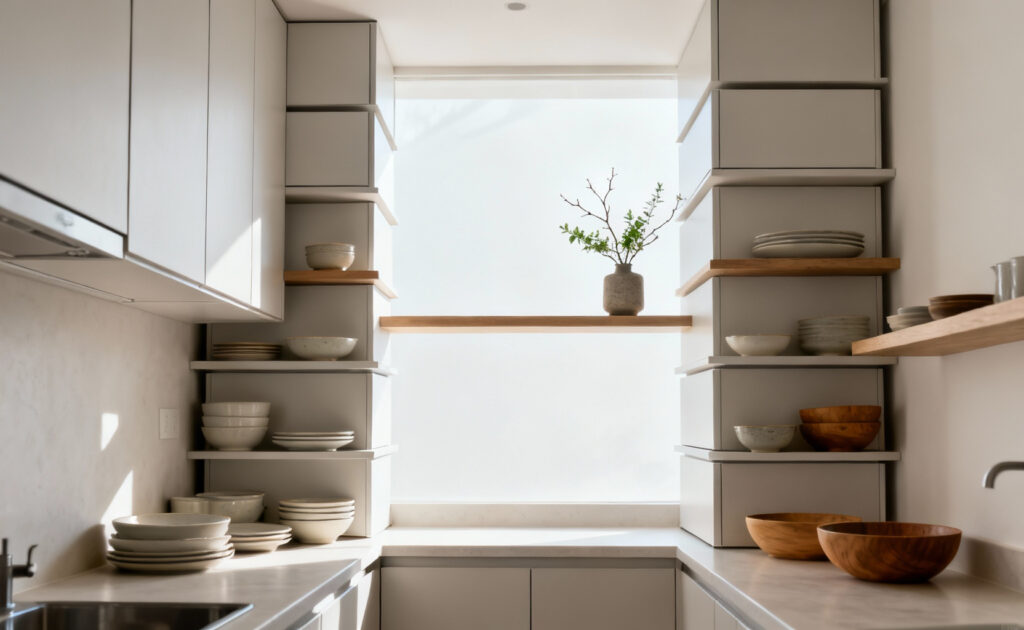There’s a prevailing belief that small kitchen decor is an exercise in sacrifice, a battle against the inevitable tide of clutter and claustrophobia. Design blogs repeat it, and home improvement shows preach it. Here’s what they’re not telling you: From my work in wellness architecture, where we analyze how spaces impact our nervous system, I’ve found that true ingenuity and serenity thrive precisely within these so-called boundaries. These 20 evidence-backed strategies will show you how to move beyond simple space-saving hacks and transform your kitchen into a sanctuary that truly supports your well-being.
This isn’t just about clever storage. It’s about a holistic re-evaluation of how your kitchen functions, feels, and contributes to your daily life. We’re going to explore how to manipulate spatial perception, integrate biophilic principles for mental calm, and create an ergonomic flow that reduces physical and mental friction. My goal is to empower you to approach your small kitchen decor with a newfound authority, seeing your space not as a problem to be solved, but as a canvas for a more intentional life.
Essential Fundamentals: Cultivating Spatial Serenity
Before we can create a space that feels expansive, we must first master the fundamental principles of perception and order. This is the groundwork—the essential truths of how to create a sense of calm and control in a compact environment, setting the stage for more advanced applications.
1. Maximize Verticality with Strategic Storage Stacks
Your kitchen’s floor space is a finite resource. So, why do we focus so much of our attention there? The first, most immediate shift is to look up. Start by simply thinking vertically—stacking plates, using tiered organizers in cupboards. This is about retraining your eye to see the volume of your room, not just the square footage.
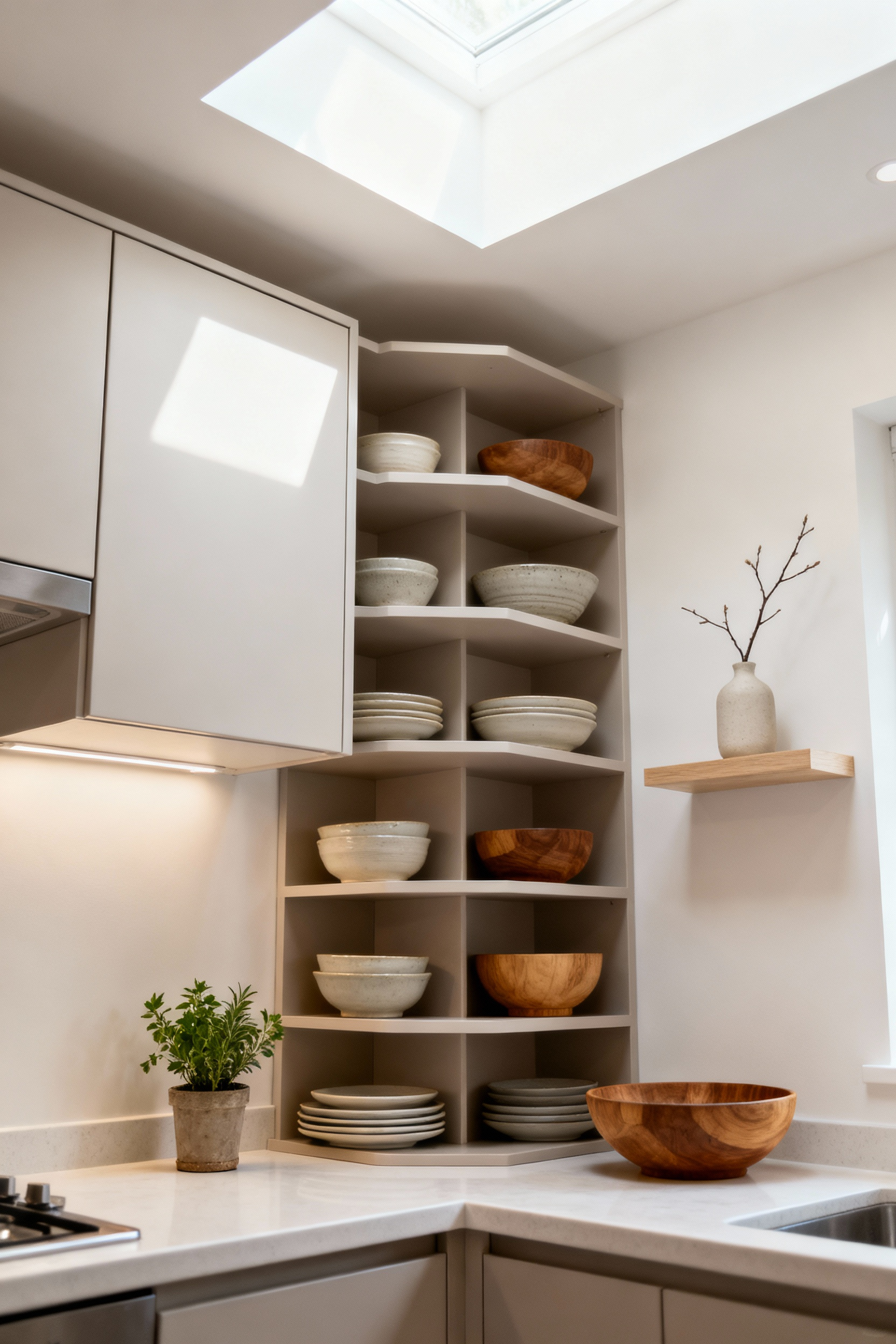
Building from there, we can get more intentional. Open shelving installed above your counter draws the eye upward and turns everyday items—beautiful ceramic bowls, a collection of tea tins—into part of your decor. What I find in my wellness design practice is that having your most-used items visible and accessible reduces “decision friction,” that tiny bit of stress you feel rummaging through a cluttered drawer. By integrating floor-to-ceiling cabinetry or a slim pantry unit, you create a seamless vertical line that makes the ceiling feel higher, transforming storage into an architectural feature that expands the room.
2. Harness Reflective Surfaces for Amplified Luminosity
Light is your most powerful ally in a small kitchen. The way a space reflects light has a profound impact on how large and airy it feels. An easy starting point is a simple, high-gloss finish on a few key items, like a kettle or a utensil holder. Even these small points of light will bounce around the room.
To take it a step further, consider a backsplash made of glossy ceramic or glass tile. When hit by under-cabinet lighting, it creates a radiant effect that dissolves shadows and brightens the entire workspace. The more sophisticated application of this principle is about layering different types of reflectivity. Think of the subtle sheen of a polished quartz countertop, the gentle gleam from satin nickel hardware, and the crisp reflection of a small, well-placed mirror. This isn’t about creating a hall of mirrors; it’s about orchestrating a gentle play of light that makes the space feel alive and expansive.
3. Streamline Countertops Through Deliberate Decluttering
A cluttered countertop is visual noise, and in a small kitchen, that noise can be deafening. The single most impactful thing you can do, right now, is to clear your counters of everything that isn’t essential for daily use or genuinely beautiful. Ask yourself: does this need to live here? If it’s not used every day, find it a home in a cabinet or drawer. This creates immediate visual breathing room.

This isn’t about a one-time purge. It’s about creating systems. I encourage my clients to establish a “five-minute reset” at the end of each day to return items to their designated homes. Grouping essentials like olive oil and salt on a small, elegant tray contains them visually and makes the counter easy to wipe clean. This habit of intentional curation transforms your counter from a chaotic drop-zone into a serene and functional workspace, which in turn reduces your cognitive load and makes cooking feel less like a chore.
4. Opt for Visually Lightweight Furniture
Heavy, solid furniture can feel like an anchor in a small kitchen, visually weighing the whole room down. The key is to choose pieces that allow you to see the floor and walls through them. This creates an uninterrupted sightline that tricks the brain into perceiving more space.
Think bar stools with slim metal legs instead of a solid wood base. Or a dining table with a glass top. These materials don’t block light or sight. One of my favorite—and often overlooked—options is furniture made of clear acrylic. A “ghost” chair or stool provides full function while taking up almost zero visual space. It’s an incredibly effective way to preserve a sense of openness and flow without sacrificing the seating you need.
5. Employ Monochromatic Color Palettes for Seamless Cohesion
Bold, contrasting colors create visual stops and starts, effectively chopping a small space into even smaller pieces. A monochromatic palette—using various shades and tints of a single color—does the exact opposite. It creates a seamless, flowing canvas that blurs the room’s boundaries, making it feel more expansive.
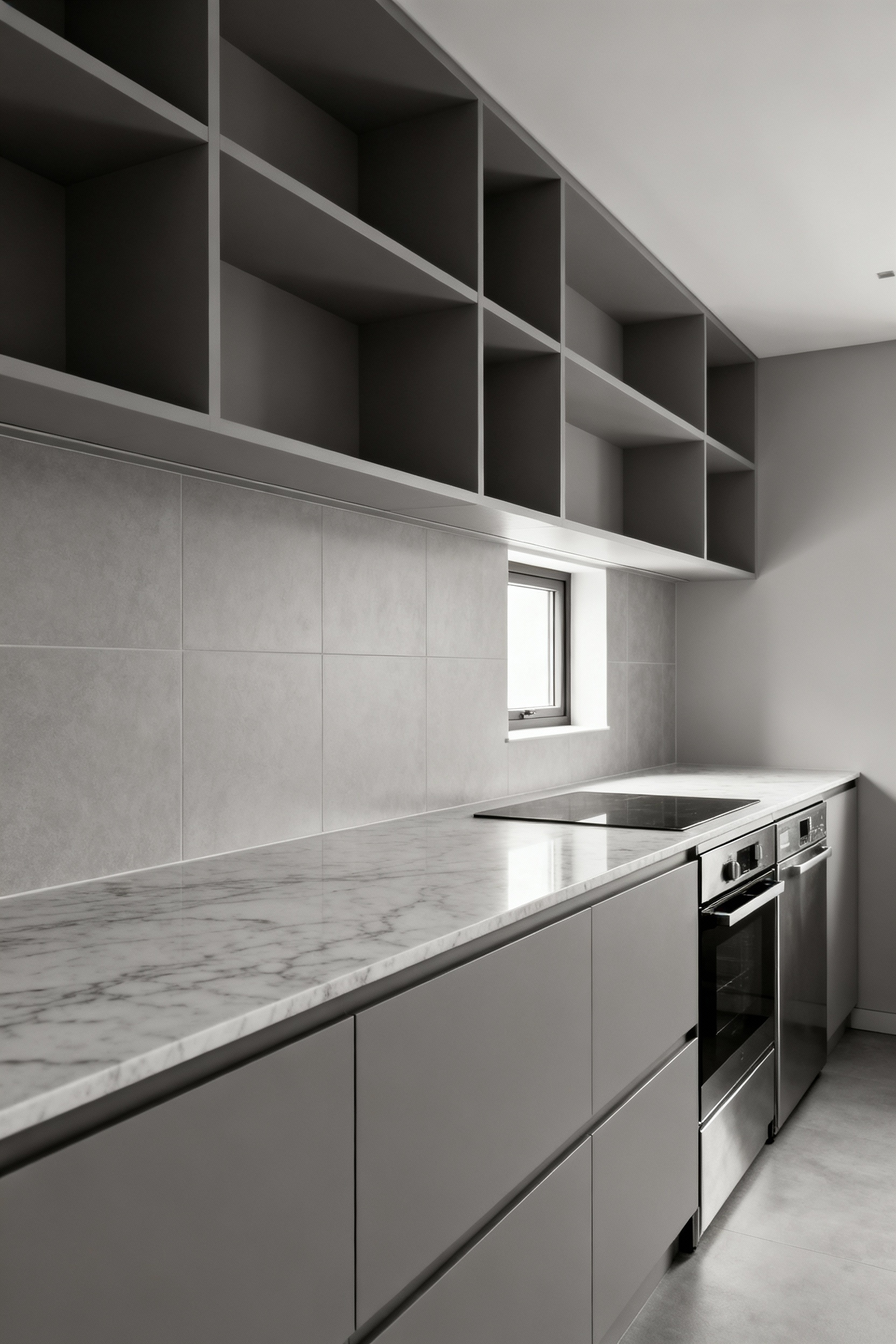
This doesn’t mean your kitchen has to be boring or sterile. The magic is in the texture. Imagine a kitchen in shades of soft grey: matte finish cabinets, a polished light grey quartz counter, and a slightly darker grey tile backsplash with a subtle texture. Each surface interacts with light differently, creating depth and interest without disrupting the visual harmony. In my work with Mindful Space Planning, I’ve seen how these calm, cohesive environments can genuinely lower stress levels. They quiet the visual noise, allowing the mind to relax and focus.
Elevating Your Approach: Crafting Integrated Environments
Once the foundations are in place, we can begin to weave individual elements together into a cohesive whole. This is where your small kitchen starts to feel less like a collection of clever tricks and more like a single, thoughtfully designed environment.
6. Integrate Multifunctional Furnishings for Dynamic Utility
In a small kitchen, every object should earn its keep, and ideally, it should perform more than one job. This is about moving beyond static furniture and embracing pieces that adapt to your needs. A simple starting point is a butcher-block island on casters—it’s prep space, storage, and a serving cart all in one.
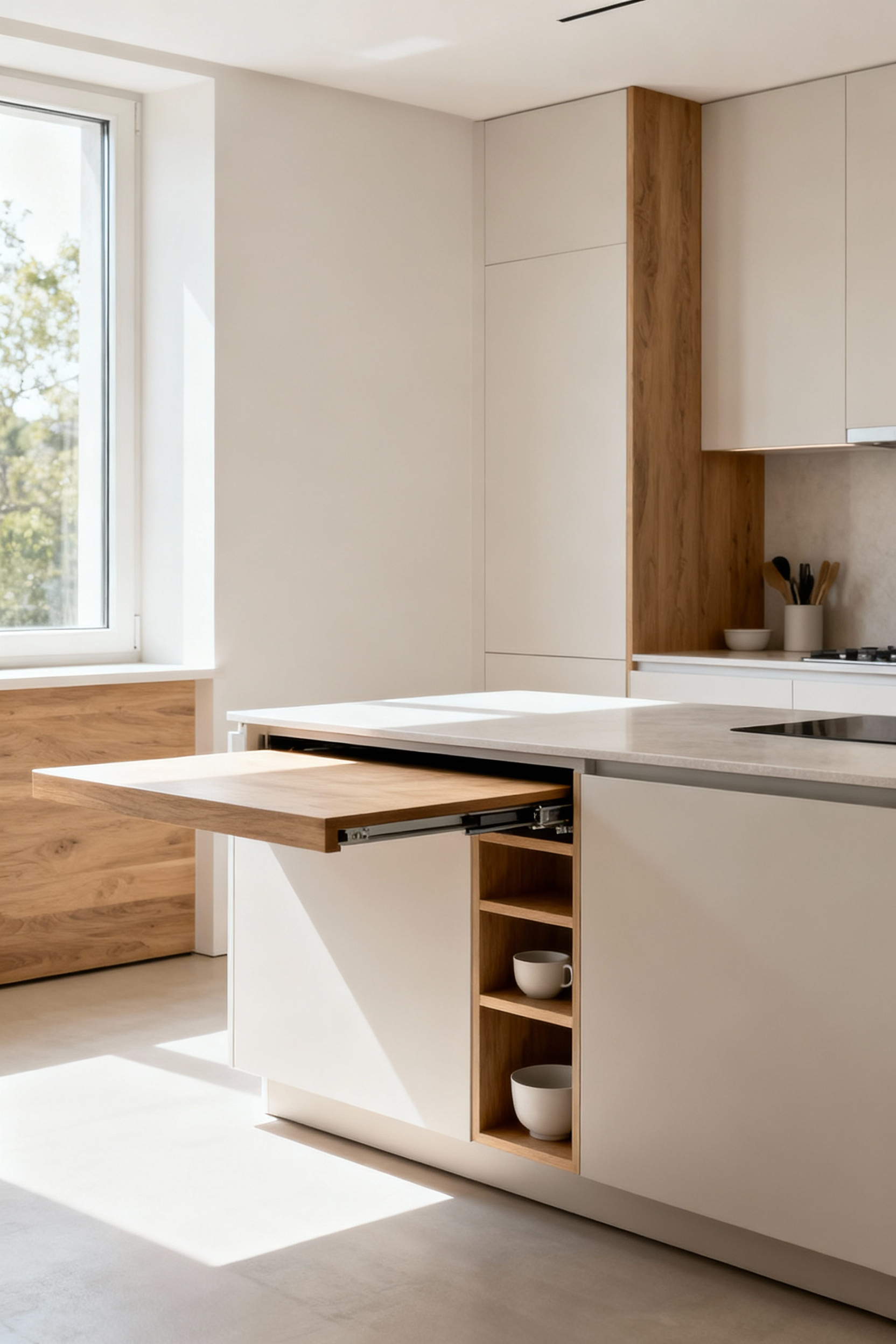
But we can take this concept much deeper. Consider built-in banquette seating with hidden storage drawers underneath. It’s more space-efficient than a table and chairs and provides a home for bulky items. One of the most elegant solutions I’ve seen was a section of a countertop that could slide out to become a two-person dining table, completely vanishing when not in use. This level of integration transforms the kitchen from a fixed space into a responsive environment that fluidly shifts to support your life.
7. Leverage Under-Cabinet Lighting to Dissolve Visual Barriers
Lighting does more than just help you see—it sculpts your perception of a space. A single overhead light tends to cast shadows under cabinets, creating dark voids that make a kitchen feel cramped and cavelike. Installing simple LED strips under your upper cabinets is the solution.

This isn’t just for task lighting. When you illuminate the backsplash and the countertop, you achieve something almost magical: you make the upper cabinets seem to float. The harsh line between the cabinet and the wall disappears, erasing a visual boundary and making the entire area feel deeper and more open. Dimmable options allow you to shift from bright, focused light for cooking to a soft, ambient glow that turns your kitchen into a serene space in the evening.
8. Curate Cohesive Zones for Effortless Flow
Even the smallest kitchen has distinct zones for different activities: prepping, cooking, cleaning. The difference between a frustrating kitchen and a functional one often comes down to how well these zones are defined and supplied. It’s about creating an intuitive workflow.
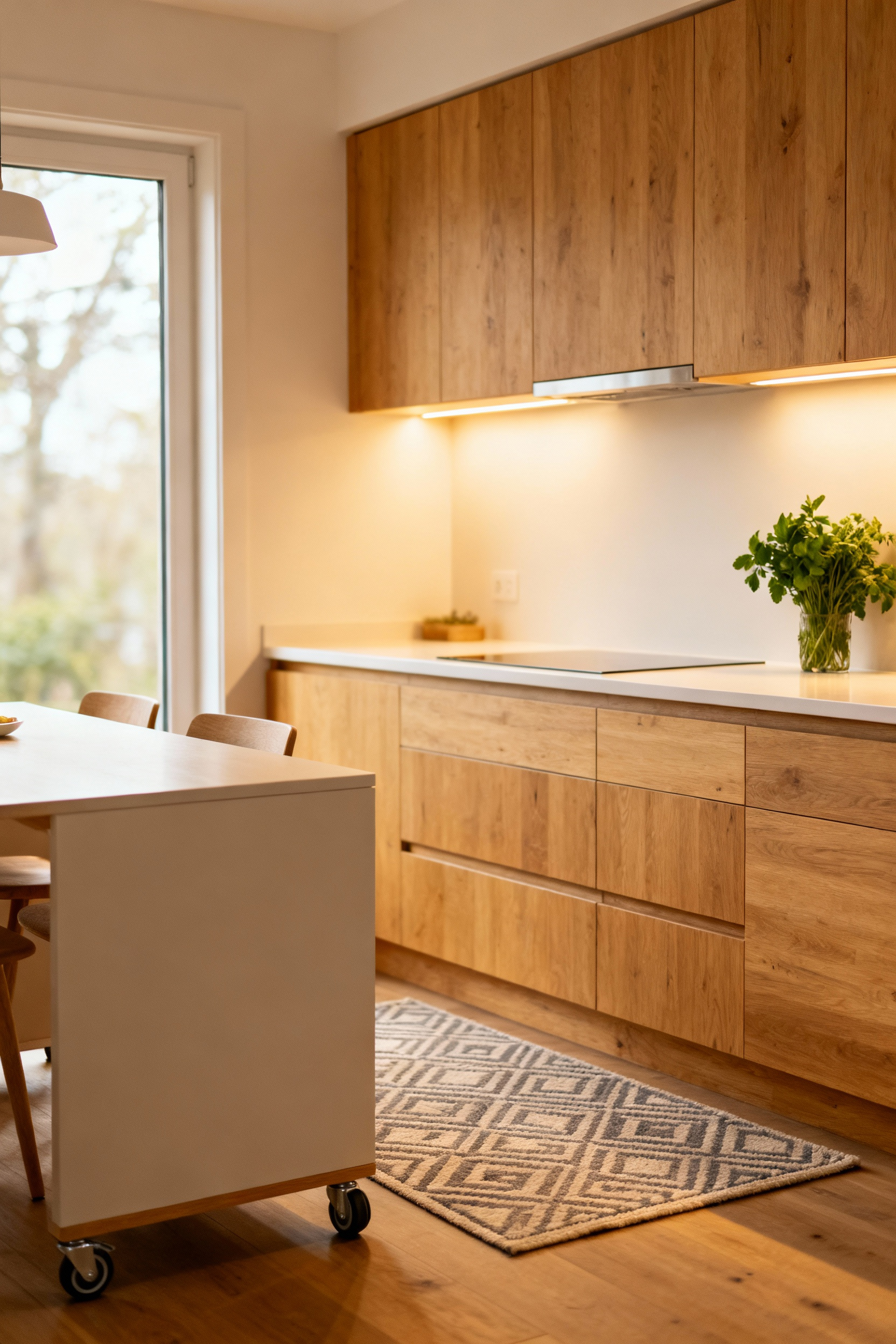
Start by storing items where you use them. Knives and cutting boards belong near your main prep surface. Spices and oils should be next to the stove. Pots and pans within easy reach of the cooktop. This sounds obvious, but it’s amazing how often these items get scattered. When you design your storage around your actions, you create an effortless dance in the kitchen, reducing physical steps and mental friction. Everything feels like it’s right where it’s supposed to be.
9. Introduce Integrated Appliances for Uninterrupted Lines
Appliances are functional necessities, but their bulky, mismatched forms can visually fracture a small kitchen. Integrated, panel-ready appliances are the answer. By covering your dishwasher or refrigerator with panels that match your cabinetry, you make them disappear.

The result is a serene, uninterrupted sweep of cabinetry that creates a powerful illusion of spaciousness. The eye flows smoothly across the surface, with no jarring blocks of stainless steel to break the line. This is a higher-investment strategy, but the payoff in visual calm is enormous. It elevates the kitchen from a purely utilitarian room to a seamless, beautifully integrated part of your home’s architecture.
10. Implement Layered Lighting for Depth Perception
We’ve touched on under-cabinet lighting, but a truly well-lit kitchen uses a layered approach. Think of it in three parts: ambient (overall light), task (focused light), and accent (decorative light). The combination is what creates mood and a sense of depth.
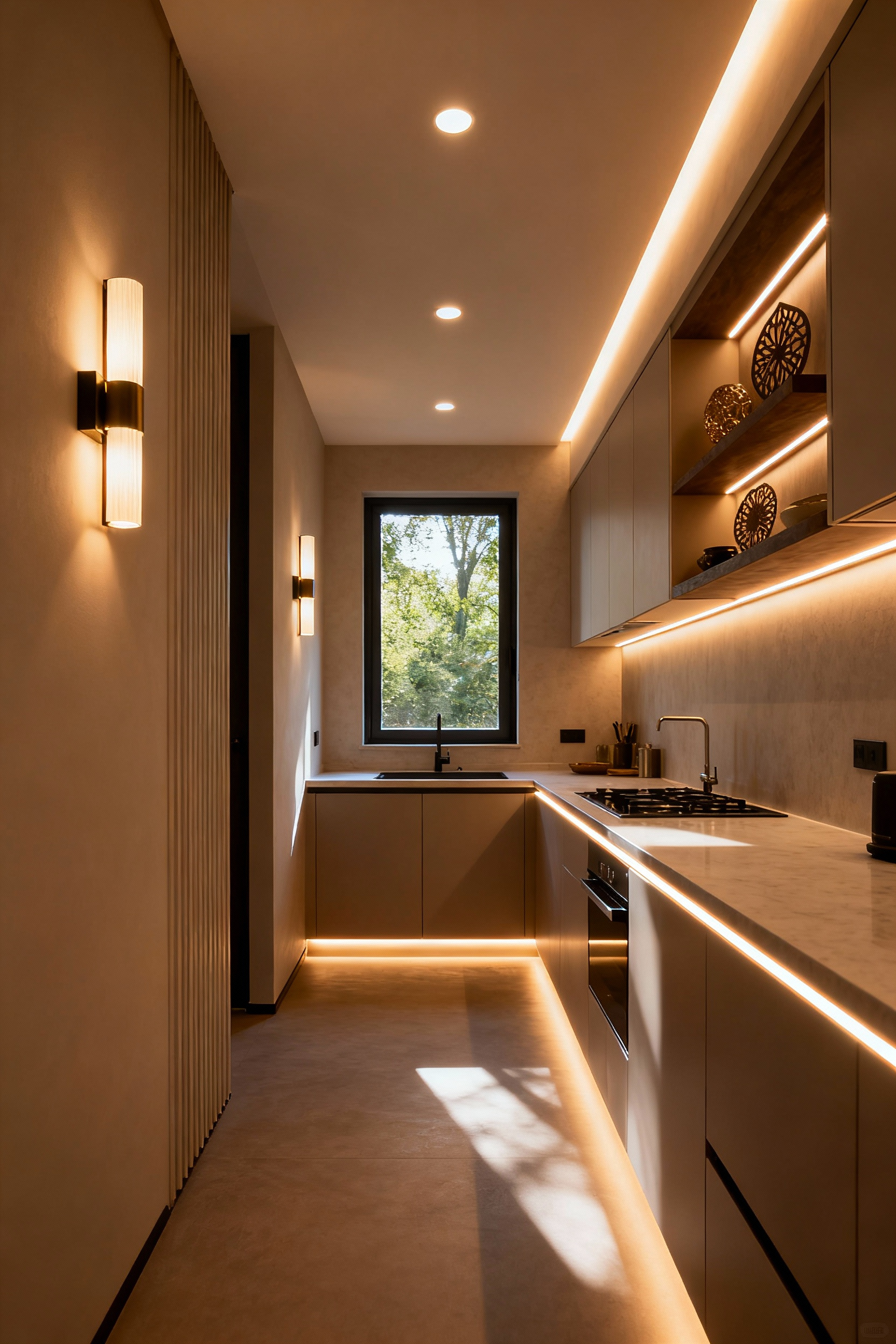
Ambient light might come from recessed ceiling lights or a beautiful central fixture. Task lighting, as we discussed, illuminates workspaces. Accent lighting is the final touch—perhaps a single, beautiful pendant light over a small island or sconces on a wall. This interplay of light and shadow prevents the space from feeling flat. Here’s what’s interesting: our brains are hardwired to feel safer and calmer in environments with varied light, as it mimics the dappled light of a natural setting. Layering light in your kitchen isn’t just a design trick; it’s a way to tap into our innate need for a secure, nurturing environment.
Advanced Strategies: Harmonizing Form and Function
Now we move into a realm where design becomes truly transformative. These strategies blend sophisticated aesthetics with deep functionality, creating a small kitchen that feels not just spacious, but truly special.
11. Design Custom Cabinetry with Intelligent Internal Organization
Off-the-shelf cabinetry works within standard sizes, but small kitchens are rarely standard. Custom cabinetry is designed to fit your space to the millimeter, making use of every last inch from floor to ceiling and wall to wall. This eliminates awkward gaps that just collect dust.
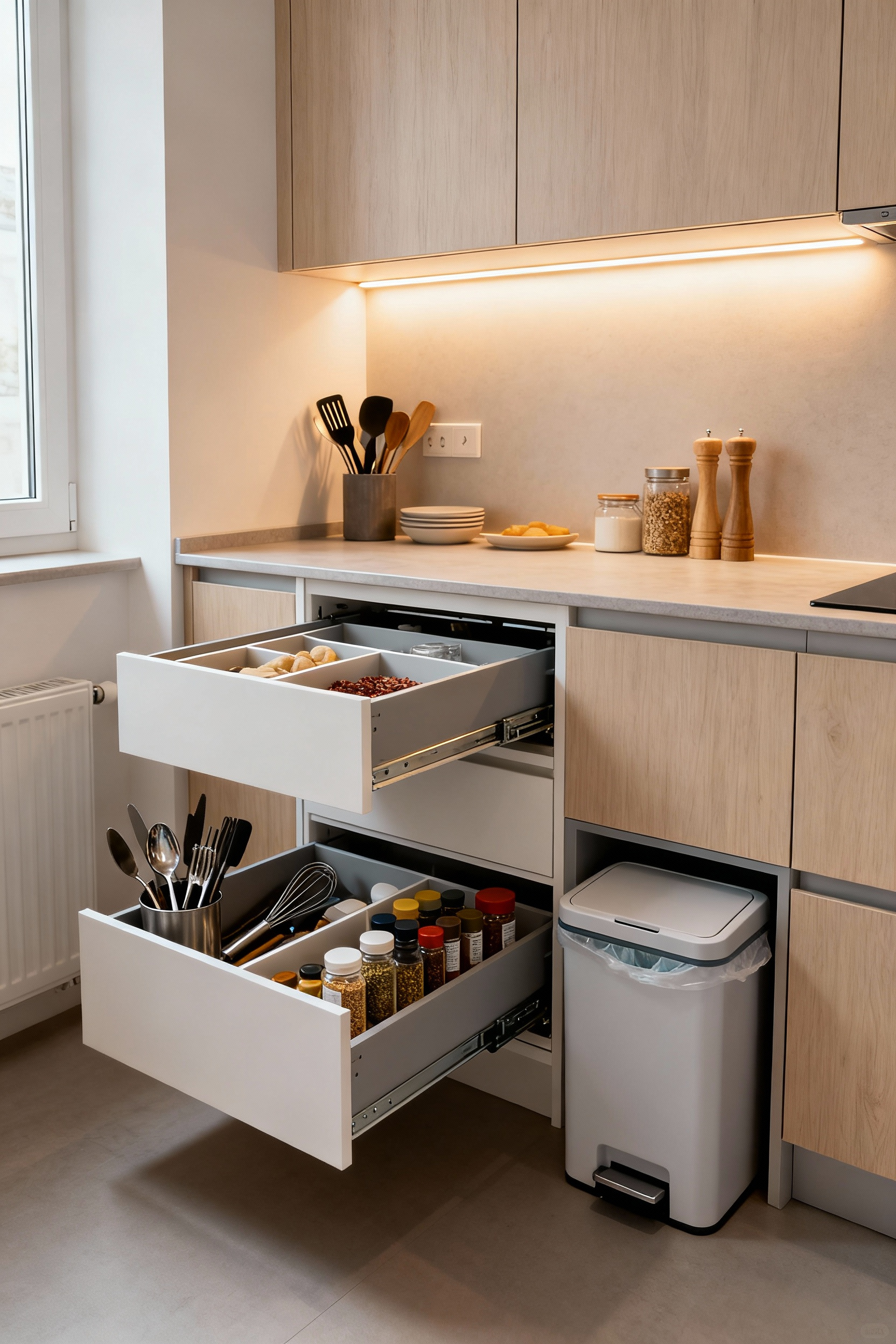
But the real magic happens inside. Think beyond shelves. Specify deep drawers for pots and pans—so much easier than digging in a low cabinet. Integrate pull-out pantries, vertical dividers for baking sheets, and corner cabinet carousels that bring items to you. You can even design a dedicated “appliance garage” with a retractable door to hide the toaster and blender, keeping your countertops completely clear. This level of intentionality makes your kitchen feel like it was built just for you, because it was.
12. Employ Trompe l’Oeil for Perceptual Space Expansion
Trompe l’oeil, French for “deceive the eye,” is the art of using realistic imagery to create an illusion of depth. While a full-blown mural might be ambitious, the principle can be applied in subtle ways. A strategically placed mirror is the simplest form, instantly doubling a view or a light source.
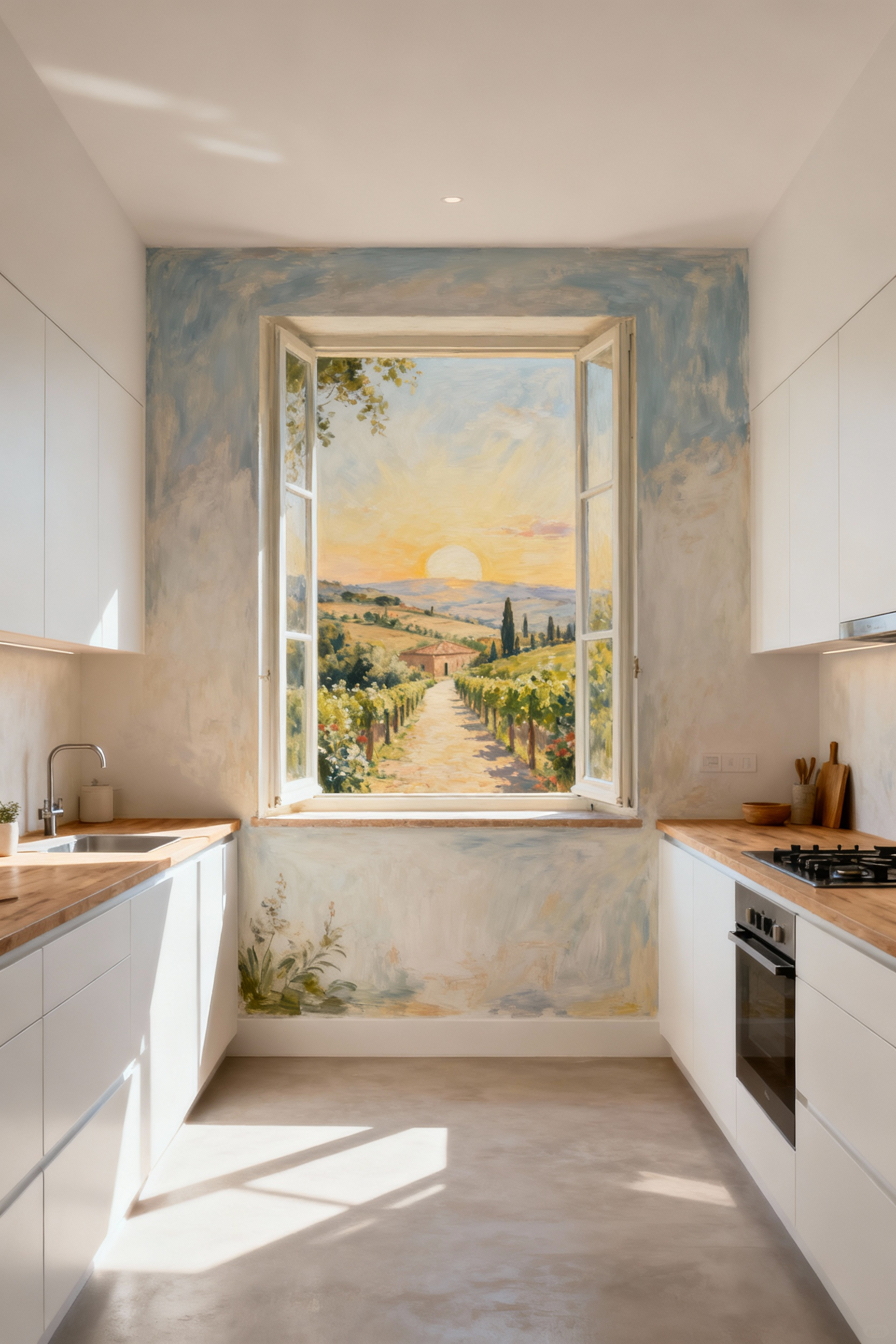
A more sophisticated approach might be a backsplash of tiles that create a deep, receding geometric pattern, tricking the eye into seeing more depth than actually exists. Or a wallpaper on a single feature wall that depicts a soft, atmospheric landscape, suggesting a view beyond the physical room. When done well, these techniques add a touch of wit and wonder, transforming a flat wall into a portal that subtly expands the room’s perceived boundaries.
13. Adopt a Biophilic Design Framework
Biophilic design is the practice of connecting us to nature within our built environments. This connection is scientifically proven to reduce stress and improve mental clarity. The simplest way to start is with plants—a small pot of herbs on the windowsill not only provides fresh ingredients but also a vital splash of green.

In my wellness design practice, this is a non-negotiable principle. We need that connection. To go deeper, integrate natural materials. A wooden cutting board, a stone fruit bowl, cabinetry made from light-toned wood like white oak or birch. These materials have natural textures and imperfections that are grounding to our senses. Maximizing natural light by keeping window treatments minimal also reinforces our connection to the time of day and the world outside. Your kitchen becomes more than a place to cook; it becomes a subtly restorative space.
14. Develop a Comprehensive Material Palette for Sensory Richness
A small space can feel flat if all the surfaces are the same. A thoughtfully curated palette of materials adds a layer of sensory richness that makes the kitchen feel more dynamic and engaging. This is about creating a dialogue between different textures.
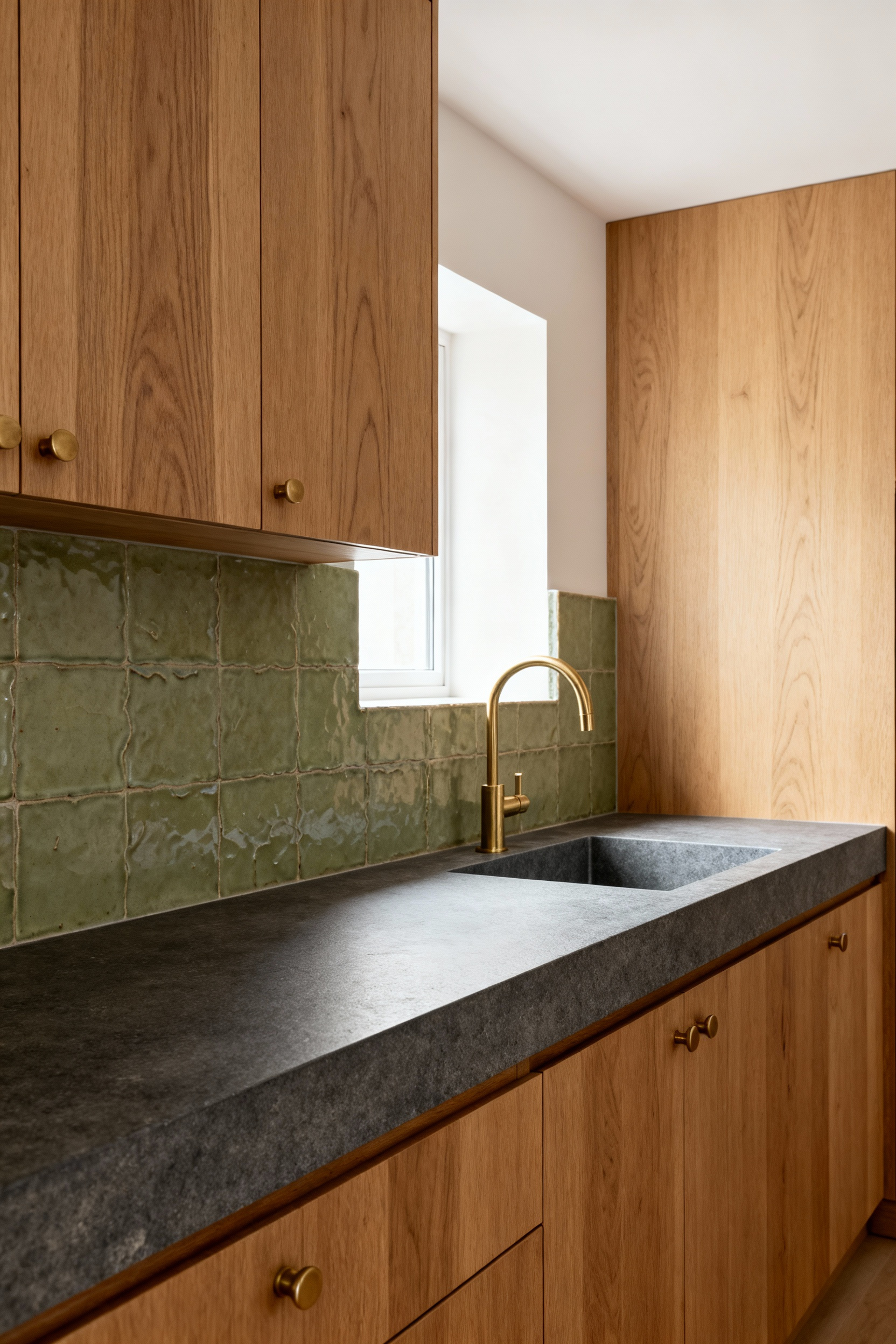
Pair the cool, smooth surface of a marble or quartz countertop with the warmth of wooden cabinets. Contrast a glossy tile backsplash with matte black hardware. Use natural fibers for a Roman shade or a runner on the floor. Each material offers a different tactile experience and interacts with light in its own unique way. This layering creates a sense of depth and sophistication that has nothing to do with size.
15. Prioritize Ergonomic Flow to Reduce Strain
Ergonomics is the science of designing for efficiency and comfort. In a small kitchen, where every step counts, an ergonomic layout is crucial for reducing physical and mental strain. This starts with the classic “work triangle”—the relationship between the sink, stove, and refrigerator. Keeping these three points relatively close and unobstructed minimizes movement.

But it goes deeper than that. Consider countertop height—is it comfortable for you? Think about the direction cabinet doors open, ensuring they don’t block a pathway. Install drawers instead of low cabinets wherever possible to avoid deep bending. I learned this when working on a kitchen for an older couple aiming to age in place; small ergonomic choices, like pull-out shelves and lever-style faucet handles, made a world of difference in their daily comfort and independence. An ergonomic kitchen is one that feels like it’s working with you, not against you.
Mastering Intuitive Design: For a Mindful Lifestyle
This is the ultimate goal: to create a kitchen that feels so natural and intuitive that it becomes a seamless extension of your intentions. It’s a space that supports a mindful approach to the daily rituals of cooking and nourishment.
16. Implement Smart Technology for Seamless Operation
Smart technology, when used thoughtfully, can reduce friction and free up your mental energy. This isn’t about gimmicks; it’s about seamless assistance. Start with something simple, like a voice-activated smart speaker for setting timers, converting measurements, or adding to your grocery list without touching anything.
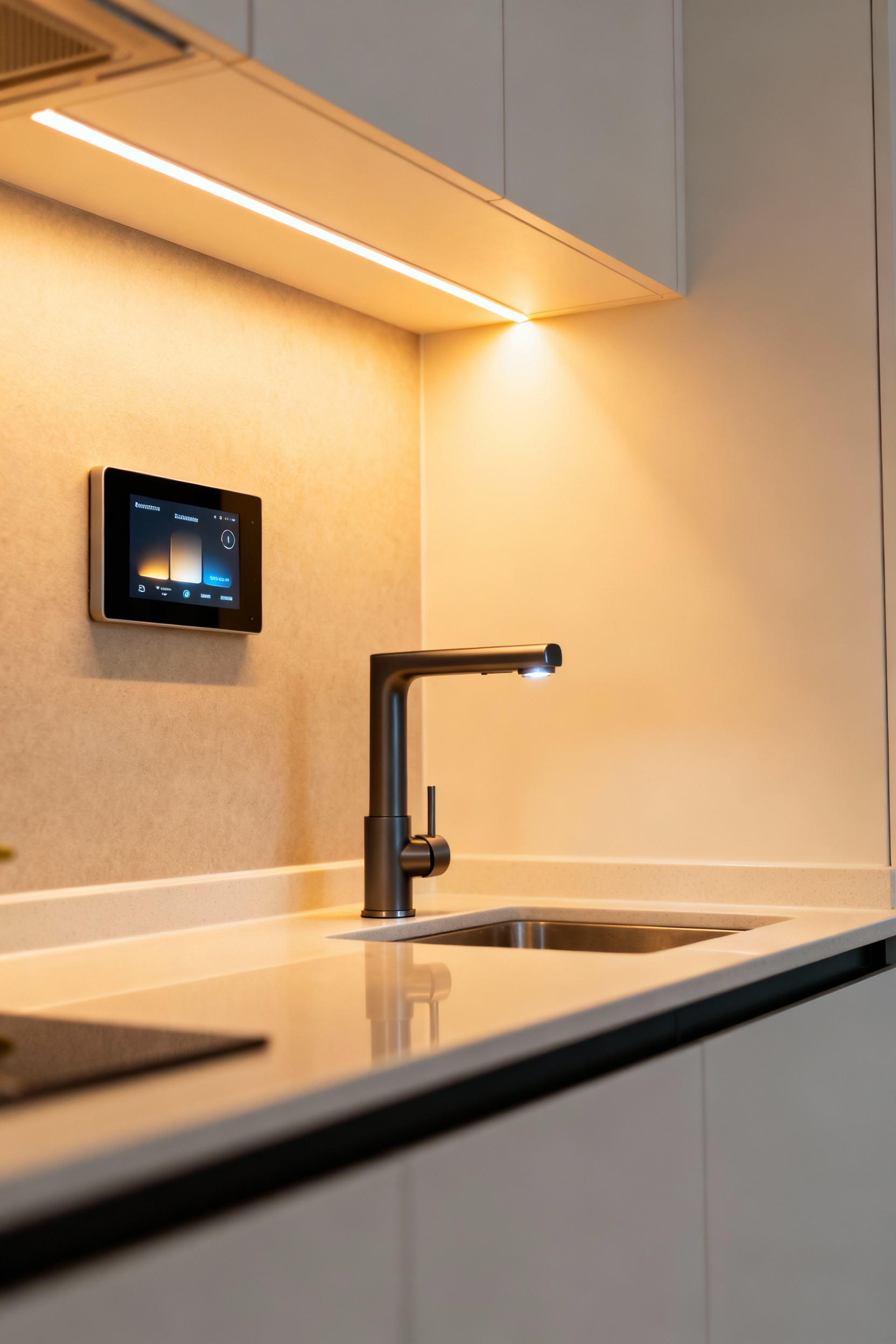
More integrated systems can have a profound impact. Imagine smart, tunable under-cabinet lighting that shifts from cool and bright in the morning to warm and relaxing in the evening, supporting your natural circadian rhythms. Or a quiet, efficient induction cooktop that heats instantly and is incredibly easy to clean. The goal of technology here is not to add complexity, but to remove it, automating small tasks so you can focus on the creative joy of cooking.
17. Cultivate Personal Narrative Through Curated Object Display
Your home should tell your story, and the kitchen is a perfect place for a few meaningful chapters. Instead of generic decor, curate a display of objects that have personal significance. A small, open shelf can hold a collection of handmade ceramic mugs, a piece of art from your travels, or your grandmother’s beloved cookbook.

These aren’t just things; they are touchstones of memory and identity. Seeing them as you go about your day infuses routine tasks with meaning and warmth. This practice transforms a purely functional space into one that feels deeply personal and nurturing. It’s a quiet reminder of who you are and where you’ve been, right in the heart of your home.
18. Engineer Adaptable Spaces with Modular Elements
The needs of a kitchen can change from day to day, or even hour to hour. Modular and transformable elements allow your space to adapt on the fly. A rolling kitchen cart can be an extra prep surface one minute and a bar cart the next. A wall-mounted drop-leaf table provides a dining spot when you need it and folds away to nothing when you don’t.

More advanced solutions might involve a countertop that pulls out to reveal a hidden extension, or a banquette seat on hinges that lifts to reveal storage. This is about designing for flexibility, recognizing that a small space needs to be a hard-working chameleon. Your kitchen is no longer a static room but a dynamic, reconfigurable platform for living.
19. Embed Sustainable Principles for an Eco-Conscious Haven
A truly well-designed space should not only nurture you but also be gentle on the planet. This can start with simple choices: opting for energy-efficient appliances, using non-toxic cleaning supplies, and setting up a convenient system for composting and recycling.
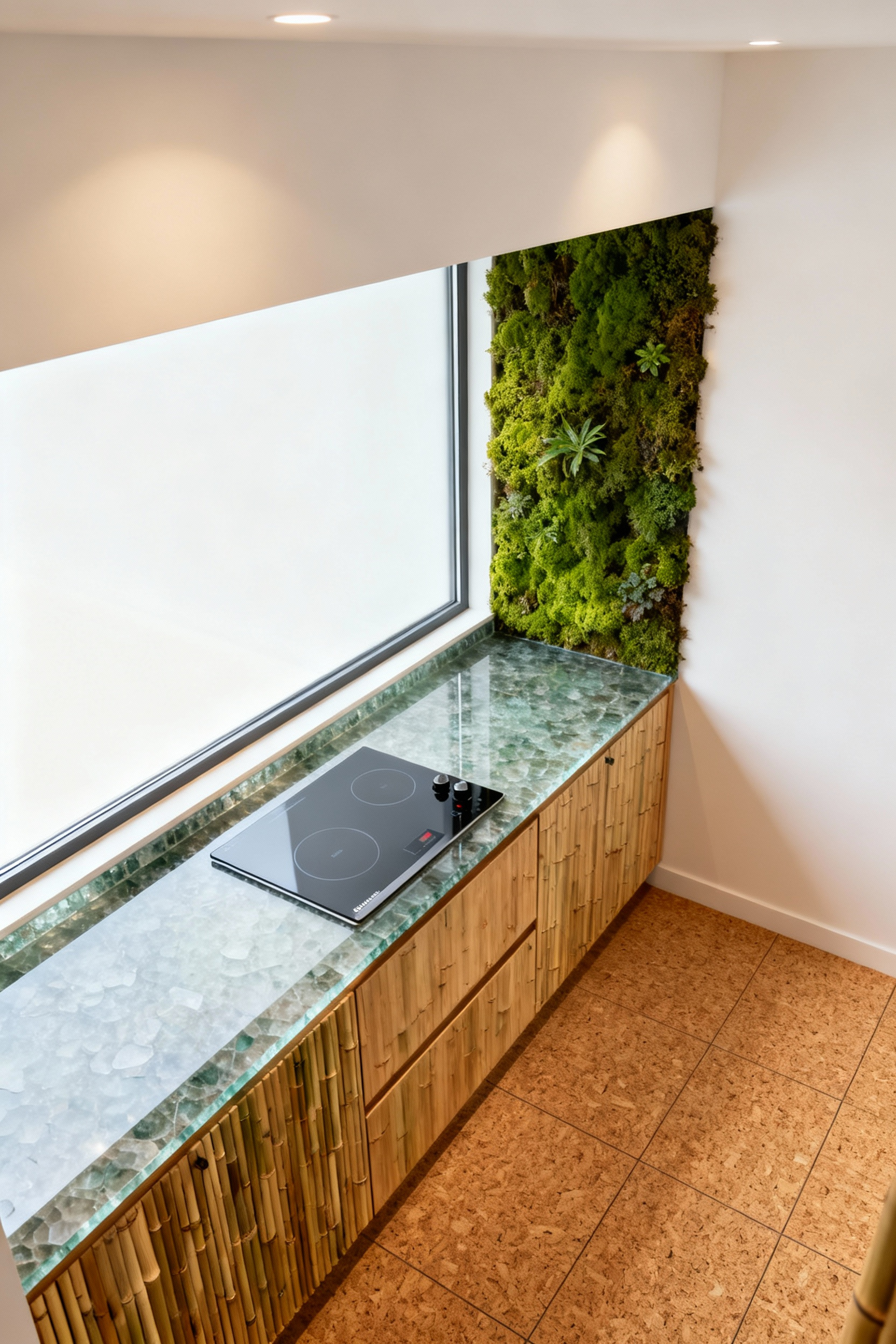
To take it further, choose materials with care. Look for cabinetry made from reclaimed wood or sustainably harvested bamboo. Select countertops made from recycled content. Use low-VOC (volatile organic compound) paint to ensure healthy indoor air quality. These choices create a kitchen that aligns with your values—a space that is healthy for both your family and the environment.
20. Articulate Intentional Empty Space
In our quest to maximize storage, we often forget the profound power of empty space. Negative space—a clear counter, an unadorned wall—is not wasted space. It is a place for the eye to rest. It is visual silence. In a small kitchen, this is perhaps the most advanced and essential principle of all.

From my years of Mindful Space Planning, I’ve seen that visual clutter creates cognitive load. By intentionally leaving some surfaces clear and some walls bare, you create a sense of calm and order that is deeply restorative. It allows the few beautiful or functional things you do display to have a much greater impact. It’s the ultimate act of curation—knowing that sometimes, the most important design decision is to add nothing at all.
Conclusion
We’ve journeyed far beyond the conventional wisdom that a small kitchen means a life of compromise. By moving through these twenty strategies, we have dismantled that myth. We started with foundational principles that manipulate perception and culminated in a mastery of intuitive design that supports a mindful, serene lifestyle. This isn’t about tricks; it’s a systematic approach to transforming limitations into sources of profound creativity.
What I hope you see now is that a small kitchen isn’t a problem. It is a powerful invitation to be intentional. It demands that you consider every choice, from the texture of a cabinet pull to the quality of your light. By embracing these principles, you don’t just “deal with” a small space—you elevate it into a highly efficient, deeply personal, and beautifully functional sanctuary. The power to redefine your kitchen’s potential is now in your hands. Approach your space not with frustration, but with the quiet authority of knowing that the most thoughtful design often emerges from the most intimate of canvases.
